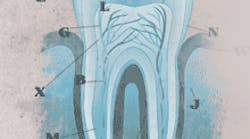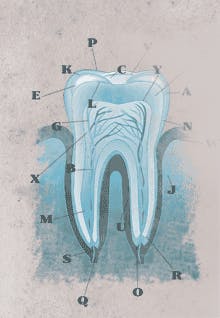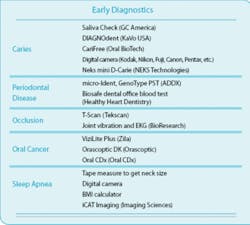Practicing Within the Minimal Intervention Philosophy Part II
by Shirley Gutkowski, RDH, BSDH, FACE
Diagnostics are the most overlooked part of our job. Well, maybe not so much anymore. We have some pretty fantastic products to help us make sure we get our information accurately and quickly. The explorer and the educated, unaided eye are primitive and good tools — much the same as an air pressure gauge is to increasing gas mileage. It"s a start.
Caries Detection
Saliva evaluation has received much press in the last few years, mainly because we have a good chairside option to use. In the past, we had only incubator tests to evaluate the quality of the saliva and also present a total count of the colony-forming units (CFU). The focus on biofilm as a community of bacteria may or may not change the relationship we have with CFU. Testing saliva pH and buffering capacity is very important to the well-being of the enamel. The wrong pH creates a wonderful growing habitat for pathogenic bacterial growth.
When and who: This would be done for each new patient, and anyone who presents with new decay.
Lesion detection in the hard tissue is another matter altogether. A digital camera is useful in following the size of a lesion, and seeing if it"s responding to treatment. The digital aspect of the camera allows the user the ability to magnify areas of the tooth to see if the spot is cavitated.
When and who: Any person who is undergoing restorative treatment for a caries infection.
Laser caries detection has been around for nearly a decade. The light created makes the cariogenic products glow, the tip then reads the amount of glow and calculates it into a reading a clinician can write down. When the next clinician comes around, the same reading shows up, giving continuity to the diagnosis and the ability to monitor the therapy. The DIAGNOdent operates as described; NEKS, now owned by Dentsply, operates on a different level. They are both noninvasive, allowing the clinician to treat the early lesion before excision of the diseased tissue is necessary.
When and who: Every tooth on every patient, every appointment.
Oral Cancer
The most important thing about minimal intervention is detecting the problem early. For soft tissue, it"s the same principle. Technology detects cell changes, and, by testing spots, we can lower the number of deaths due to oral cancer.
The ViziLite system or the new Orascoptic DK system allows us to really see what wasn"t visible before. The rinse cleans up the tissue and gives the light a better chance at reflecting tissue abnormalities. Once visible, the clinician can act. The first action is to look for a reason for the disturbance. Is it really a corn chip rip or something else? Educated clinicians are the first line of all advanced diagnostics.
When and who: First do a full normal head-and-neck oral cancer screening and at least once a year do the advanced screening (see RDH December 2007).
Invasive tests are next. If the lesion or spot has no known etiology and is small, a brush test is in order. It"s easy, and, if done incorrectly, the computer sample reader will let the clinician know that dysplastic cells are there.
The brush test illustrates the ability to prevent cancer by detecting dysplasias in very small spots. Once detected, the spot is removed by an oral surgeon and biopsied further — kind of like treatment and diagnosis at the same time. If the lesion is very scary looking, refer immediately for excisional biopsy.
It"s important to remember that as children become sexually active earlier and earlier, the human papilloma virus becomes a bigger problem for girls and boys. Spots on young adults are no longer easily dismissed.
When and who: Do this for every spot you can"t attribute to trauma for any person at any age.
Periodontal Disease
Malocclusion plays a part in periodontal disease. Available technology measures the amount of pressure on multiple parts of each tooth, detecting imbalances throughout the mouth. The T-Scan (Tekscan) can help clinicians find minor issues that can be addressed with little fanfare or tissue destruction. It"s also simple for a hygienist or dental assistant to take the reading. Small changes can also be monitored over time.
EKG devices for detecting facial muscle imbalances are also available for dentistry. Preventing periodontal disease is an indirect way to save a life.
When and who: This test should be done at all new patient exams as well as before and after any restorative or esthetic treatment.
Then there"s the early detection of periodontal infections and the potential disease. Today it"s important to detect the potential of periodontal disease as part of the esthetic case workup. ADDX is a DNA test that serves two purposes. The first is to detect certain pathogens in the pocket and help with determining the type of antibiotics to prescribe. The other purpose is a risk assessment. A cheek swab is sent to the lab where the gene-carrying periodontal disease is ferreted out. If the patient carries the gene, modifications can be made in the treatment plan.
When and who: Do this test before large cases and for nonresponsive sites.
Don"t forget blood tests to detect inflammatory markers before treating for periodontal disease. Blood tests can tell if you have raised levels of C-reactive protein — an important test. A newly developed chairside test for CRP, HgA1c, and lipids is available now. Developed for the Healthy Heart system created by Dr. Ron Schefdore, three small drops of blood on a card is all that"s needed. The card is sent to the lab for results. If the results don"t change after it looks like the infection has cleared up, it"s time to refer to a physician.
When and who: This test is done before and after any perio treatment.
Sleep Apnea
Sleep apnea diagnostics and treatment are evolving in dentistry. Most diagnostic tests occur in the sleep lab overnight. But that doesn"t mean you won"t have anything to offer. A tape measure to get the neck size of the suspected apneic is helpful — 17 inches being the magic number (see RDH January 2008). A digital camera to take a photograph of the pharynx, including the uvula, for measurement is also an asset.
A body mass index (BMI) calculator is also helpful. The iCAT imaging system (Imaging Sciences International) can give the clinician a 3D view to help diagnose and plan treatment for apnea and other issues related to dentistry, such as TMJ or implant placement.
When and who: Do this for all patients that present with high blood pressure and or complain of tiredness.
Nearly all of the companies who make diagnostic devices can have someone come to your office to do basic training. Often, someone will be available during a continuing education event for specific questions on how to do them too.
About the Author
Shirley Gutkowski, RDH, BSDH, has been a practicing dental hygienist since 1986. She is a popular speaker and award-winning author. Gutkowski and Amy Nieves, RDH, are the co-authors of “The Purple Guide: Developing Your Dental Hygiene Career,” a handbook for graduates from dental hygiene school. Gutkowski can be contacted at [email protected].








